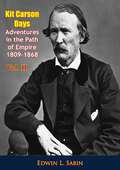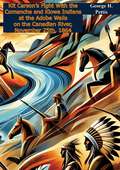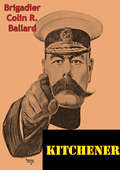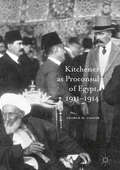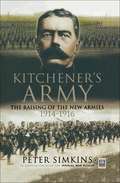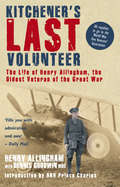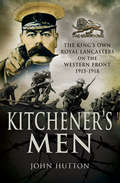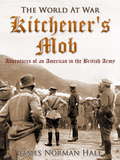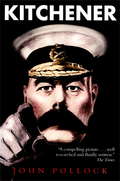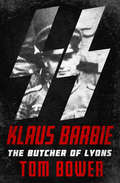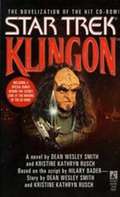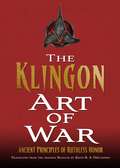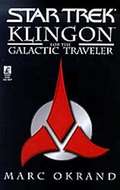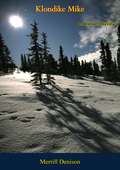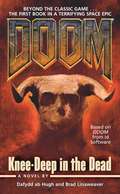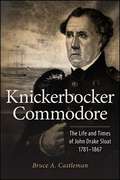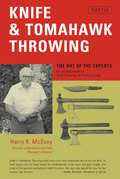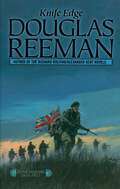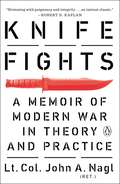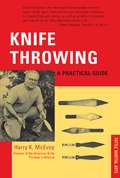- Table View
- List View
Kit Carson Days Adventures in the Path of Empire 1809-1868 vol. II (Kit Carson Days Adventures in the Path of Empire 1809-1868 #2)
by Edwin L. SabinChristopher Houston "Kit" Carson (December 24, 1809 - May 23, 1868) was an American frontiersman. The few paying jobs he had during his lifetime included mountain man (fur trapper), wilderness guide, Indian agent, and American Army officer. Carson became a frontier legend in his own lifetime via biographies and news articles. Exaggerated versions of his exploits were the subject of dime novels. In the 1840s, he was hired as a guide by John C. Fremont. Fremont's expedition covered much of California, Oregon, and the Great Basin area. Fremont mapped and wrote reports and commentaries on the Oregon Trail to assist and encourage westward-bound American pioneers. Carson achieved national fame through Fremont's accounts of his expeditions. Under Fremont's command, Carson participated in the uprising against Mexican rule in California at the beginning of the Mexican-American War. Later in the war, Carson was a scout and courier, celebrated for his rescue mission after the Battle of San Pasqual and for his coast-to-coast journey from California to Washington, DC to deliver news of the conflict in California to the U.S. government. During the American Civil War, Carson led a regiment of mostly Hispanic volunteers from New Mexico on the side of the Union at the Battle of Valverde in 1862.-Print ed.
Kit Carson's Fight With the Comanche and Kiowa Indians at the Adobe Walls on the Canadian River, November 25th, 1864
by George H. PettisStep into the dramatic and intense world of the American frontier with George H. Pettis' short, but gripping account, "Kit Carson's Fight With the Comanche and Kiowa Indians at the Adobe Walls on the Canadian River, November 25th, 1864." This detailed narrative chronicles one of the most significant battles in the Indian Wars, offering a vivid portrayal of legendary frontiersman Kit Carson and his confrontation with the Comanche and Kiowa tribes.Pettis provides a compelling account of the events leading up to and during the fierce battle at Adobe Walls. Drawing from firsthand reports and historical records, he paints a vivid picture of the harsh conditions, strategic maneuvers, and brutal combat that defined this pivotal clash. The book delves into the motivations and perspectives of both the Native American tribes defending their homeland and the U.S. military forces led by Carson.This book is an essential read for history enthusiasts, students of the American West, and anyone interested in the legendary figures and events that shaped the nation's frontier history. George H. Pettis' detailed and passionate account ensures that the legacy of Kit Carson and the Battle of Adobe Walls will not be forgotten.
Kitchener [Illustrated Edition]
by Brigadier Colin R. BallardIncludes 17 maps and the First World War Illustrations Pack - 73 battle plans and diagrams and 198 photosField-Marshal Horatio Herbert Kitchener served in the British Army from his teenage years in the Royal Engineers to his elevation to the highest military rank forty-four years later in 1916. In this balanced biography, written by a fellow British Army officer who served in the First World War, his long career in the army and as a colonial administrator is charted in vivid detail.Kitchener came to worldwide attention in 1898 for winning the Battle of Omdurman and securing control of the Sudan, after which he was given the title "Lord Kitchener of Khartoum"; as Chief of Staff (1900-02) in the Second Boer War he played a key role in Lord Roberts' conquest of the Boer Republics, then succeeded Roberts as commander-in-chief-ultimately winning the war against the insurgent Boers. After a quarrelsome term as Commander-in-Chief (1902-09) in India he returned to Egypt as Consul-General.In 1914, at the start of the First World War, Lord Kitchener became Secretary of State for War, a Cabinet Minister. One of the few to foresee a long war, he organised the largest volunteer army that both Britain and the world had seen, and oversaw a significant expansion of materials production to fight Germany on the Western Front. Despite having warned of the difficulty of provisioning Britain for a long war, he was blamed for the shortage of shells in the spring of 1915 - one of the events leading to the formation of a coalition government - and stripped of his control over munitions and strategy.Kitchener drowned on 5 June 1916 when HMS Hampshire sank west of the Orkney Islands, Scotland. He was making his way to Russia in order to attend negotiations but the ship struck a German mine. He was one of the 600 killed on board the ship.
Kitchener as Proconsul of Egypt, 1911-1914
by George. H. CassarThis book covers the tenure of Kitchener as Proconsul in Egypt in the years preceding the First World War. Based mostly on unpublished sources - including government records and private papers - it not only fills a gap in the life and career of Kitchener, the most famous soldier in Britain since Wellington, but it also deals with an important but practically unknown period in Egyptian history. George Cassar shows Kitchener to be an ardent imperialist, but one who had a sense of responsibility to the country he governed. Exchanging his field marshal's uniform for the dress of a statesman, he arrived in Egypt when British prestige was at a low point on account of his predecessor's policies. He restored political stability, created conditions that bolstered the economy, and introduced a wave of reforms. Kitchener as Proconsul of Egypt, 1911-1914 reveals how Kitchener's interest extended beyond Egypt, and how throughout these years he worked quietly to prepare the ground in an attempt to create an Arab Empire under Britain's suzerainty.
Kitchener's Army: The Raising of the New Armies, 1914–1916 (War, Armed Forces And Society Ser.)
by Peter SimkinsNumbering over five million men, Britain's army in the First World War was the biggest in the country's history. Remarkably, nearly half those men who served in it were volunteers. 2,466,719 men enlisted between August 1914 and December 1915, many in response to the appeals of the Field-Marshal Lord Kitchener. How did Britain succeed in creating a mass army, almost from scratch, in the middle of a major war ? What compelled so many men to volunteer ' and what happened to them once they had taken the King's shilling ? Peter Simkins describes how Kitchener's New Armies were raised and reviews the main political, economic and social effects of the recruiting campaign. He examines the experiences and impressions of the officers and men who made up the New Armies. As well as analysing their motives for enlisting, he explores how they were fed, housed, equipped and trained before they set off for active service abroad. Drawing upon a wide variety of sources, ranging from government papers to the diaries and letters of individual soldiers, he questions long-held assumptions about the 'rush to the colours' and the nature of patriotism in 1914. The book will be of interest not only to those studying social, political and economic history, but also to general readers who wish to know more about the story of Britain's citizen soldiers in the Great War.
Kitchener's Last Volunteer: The Life of Henry Allingham, the Oldest Surviving Veteran of the Great War
by Dennis Goodwin Henry AllinghamHenry Allingham is the last British serviceman alive to have volunteered for active duty in the First World War and is one of very few people who can directly recall the horror of that conflict. In Kitchener's Last Volunteer, he vividly recaptures how life was lived in the Edwardian era and how it was altered irrevocably by the slaughter of millions of men in the Great War, and by the subsequent coming of the modern age.Henry is unique in that he saw action on land, sea and in the air with the British Naval Air Service. He was present at the Battle of Jutland in 1916 with the British Grand Fleet and went on to serve on the Western Front. He befriended several of the young pilots who would lose their lives, and he himself suffered the privations of the front line under fire.In recent years, Henry was given the opportunity to tell his remarkable story to a wider audience through a BBC documentary, and he has since become a hero to many, meeting royalty and having many honours bestowed upon him.This is the touching story of an ordinary man's extraordinary life - one who has outlived six monarchs and twenty-one prime ministers, and who represents a last link to a vital point in our nation's history.
Kitchener's Men: The King's Own Royal Lancasters on the Western Front, 1915–1918
by John HuttonIn Kitchener's Men John Hutton provides a absorbing account of the raising, training and fighting experiences of the Service and Territorial battalions of the Kings Own Royal Lancasters in France during the Great War. His book gives a graphic insight into the daily routine and grim reality of warfare on the Western Front for men who were mostly recruited from the Furness area of the northwest. They came from the steel mills, shipyards and engineering workshops of this heavily industrialized part of Britain. They responded to the call to defend their country and its values at a critical moment in the nations history, and the endured incredible hardship, suffering and violence as a result. All together, these battalions of the King's Own took part in every major campaign on the Western Front from the spring of 1915 until the end of the war. They had a remarkable record, and John Hutton's meticulously researched history allows the reader to follow them through every phase of the fighting. His account makes compelling reading.
Kitchener's Mob / Adventures of an American in the British Army (The World At War)
by James HallJames Norman Hall (22 April 1887 – 5 July 1951) was an American author best known for the novel Mutiny on the Bounty with co-author Charles Nordhoff. During World War I, Hall had the distinction of serving in the militaries of three Western allies: Great Britain as an infantryman and then flying for France and later the United States. James Hall begins his story of Kitchener and the men who fought with him on the Western Front as follows. "Kitchener's Mob" they were called in the early days of August 1914, when London hoardings were clamorous with the first calls for volunteers. The seasoned regulars of the first British expeditionary force said it patronisingly, the great British public hopefully, the world at large doubtfully. "Kitchener's Mob," when there was but a scant sixty thousand under arms with millions yet to come. "Kitchener's Mob" it remains to-day, fighting in hundreds of thousands in France, Belgium, Africa, the Balkans. (Excerpt from Wikipedia and Goodreads)
Kitchener: The Road to Omdurman and Saviour of the Nation
by John PollockWhen the Great War broke out, Kitchener, with the foresight lacking in many of his contemporaries, insisted that it would last at least three years and that he must raise an army of 3 million men. This began with an immediate recruitment of 100,000 volunteers, and the familiar poster campaign image of him with the line "Your country needs you".Major battles and initiatives of the Great War are recreated in a dramatic narrative history which does justice to Kitchener's masterly planning. This superb double volume biography will transform our view of Kitchener and the First World War.
Klaus Barbie: The Butcher of Lyons
by Tom BowerThe true story of one of Hitler&’s most feared and brutal killers: his life and crimes, postwar atrocities, and forty-year evasion of justice. During World War II, SS Hauptsturmführer Nikolaus &“Klaus&” Barbie earned a reputation for sadistic cruelty unmatched by all but a handful of his contemporaries in Adolf Hitler&’s Gestapo. In 1942, he was dispatched to Nazi-occupied France after leaving his bloodstained mark on the Netherlands. In Lyons, Barbie was entrusted with &“cleansing&” the region of Jews, French Resistance fighters, and Communists, an assignment he undertook with unparalleled enthusiasm. Thousands of people died on Barbie&’s orders during his time in France—often by his own hand—including forty-four orphaned Jewish children and captured resistance leader Jean Moulin, who was tortured and beaten to death. When the Allies were approaching Lyons in the months following the D-Day invasion, Barbie and his subordinates fled, but not before brutally slaughtering all the prisoners still being held captive. But the war&’s conclusion was not the end of the Klaus Barbie nightmare. With the dawning of the Cold War, the &“Butcher of Lyons&” went on to find a new purpose in South America, just as tensions between the United States and the Soviet Union were escalating. Soon, Barbie had a different employer who valued his wartime experience and expertise as an anti-communist man hunter and murderer: the US intelligence services. In Klaus Barbie, investigative journalist and documentary filmmaker Tom Bower tells the fascinating, startling, and truly disturbing story of a real-life human monster, and draws back the curtain on one of America&’s most shocking secrets of the Cold War.
Klingon
by Kristine Kathryn Rusch Dean Wesley SmithThe Klingon Empire remains the Federation's most fearsome and uneasy ally, but can any human fully understand the heart and soul of a true Klingon warrior? During crucial negotiations on Deep Space Nine . Gowron, leader of the Klingon High Council, tests human understanding of the Klingon way by sharing the powerful story of one warrior's quest for honor... Pok is a young Klingon caught up in the dangerous complexities of clan politics. When his father is murdered in his own home on the day of Pok's Rite of Ascension, Pok must find the assassin and close the circle of vengeance. But as he searches for the truth amidst strange aliens and treacherous friends, Pok discovers that every day can be a good day to die and that only his own warrior's training stands between him and the business end of d'k tahg knife!
Klingon Art of War (Star Trek: The Next Generation)
by Keith R. DecandidoPassed down from the time of Kahless, ten precepts have shaped Klingon culture andindoctrinated Klingons in the Way of the Warrior. With this new translation, people from all walks of life--and all worlds--can harness the ancient Klingon wisdom and learn to embody courage, discipline, and honor.* Choose your enemies well.* Strike quickly or strike not.* Always face your enemy.* Seek adversity.* Reveal your true self in combat.* Destroy weakness.* Leave nothing until tomorrow.* Choose death over chains.* Die standing up.* Guard honor above all.
Klingon for the Galactic Traveler
by Marc Okrand"Heghlu'meH QaQ jajvam.""It is a good day to die."What is the proper response to this? What should I do?Now, with Klingon for the Galactic Traveler you will know.Organized into four easy-to-use sections, this book will guide your steps through the Klingon language and customs:The regional dialects of the EmpireCommon, everyday usage of the languageThe slang phrases and curses that color the Klingon volcabularyMost importantly, the proper verbal, physical, and cultural responses.A misspoken word to a Klingon, who is quick to take offense and even quicker to take action, could have dire consequences. This book is the indispensable guide for the galactic traveler.
Klingon for the Galactic Traveler
by Marc Okrand"Heghlu'meH QaQ jajvam.""It is a good day to die."What is the proper response to this? What should I do?Now, with Klingon for the Galactic Traveler you will know.Organized into four easy-to-use sections, this book will guide your steps through the Klingon language and customs:The regional dialects of the EmpireCommon, everyday usage of the languageThe slang phrases and curses that color the Klingon volcabularyMost importantly, the proper verbal, physical, and cultural responses.A misspoken word to a Klingon, who is quick to take offense and even quicker to take action, could have dire consequences. This book is the indispensable guide for the galactic traveler.
Klondike Mike: An Alaskan Odyssey
by Merrill DenisonKlondike Mike: An Alaskan Odyssey is Merrill Denison’s 1943 biography of Mike Ambrose Mahoney, a Canadian who travelled to the North in 1897 in search of gold and adventure. In Klondike Mike—a popular “Book of the Month Club” choice—Denison uses imagined omnipotent disclosures of his subject’s thoughts to enrich his writing with a sense of immediacy. In episodic scenes, readers accompany Mahoney through mishaps and adversity: Mahoney hauling a piano on his back up the Chilkoot Pass so that the Sunny Samson Sisters Sextette can get to Dawson to make their fortunes entertaining prospectors; or Mahoney setting a record with his team of dogs as they race across the frozen North from Dawson to Skagway in only fourteen days. The dramatic tension inherent in each of these adventures provides Klondike Mike with a surging narrative pulse and pace—a clever evocation of gold rush fever. In these ways, Klondike Mike demonstrates that Denison should be considered an early innovator of the genre now known as creative non-fiction.Richly illustrated throughout.
Knee-Deep in the Dead: A Novel (Doom #1)
by Dafydd ab HughThe Gates were there on Phobos when mankind first arrived. Inert, unyielding, impossibly alien constructs, for twenty years they sat lifeless, mute testaments to their long-vanished creators, their secrets hidden. Then one day, they sprang to life... Meet Corporal Flynn Taggart, United States Marine Corps; serial number 888-23-9912. He's the best warrior the twenty-first century has to offer, which is a damn good thing. Because Flynn Taggart is all that's standing between the hell that just dropped in on Mars and an unsuspectingg planet Earth...
Knickerbocker Commodore: The Life and Times of John Drake Sloat, 1781-1867 (Excelsior Editions)
by Bruce A. CastlemanKnickerbocker Commodore chronicles the life of Rear Admiral John Drake Sloat, an important but understudied naval figure in US history. Born and raised by a slave-owning gentry family in New York's Hudson Valley, Sloat moved to New York City at age nineteen. Bruce A. Castleman explores Sloat's forty-five-year career in the Navy, from his initial appointment as midshipman in the conflicts with revolutionary France to his service as commodore during the country's war with Mexico. As the commodore in command of the naval forces in the Pacific, Sloat occupied Monterey and declared the annexation of California in July 1846, controversial actions criticized by some and defended by others. More than a biography of one man, this book illustrates the evolution of the peacetime Navy as an institution and its conversion from sail to steam. Using shipping news and Customs Service records from Sloat's merchant voyages, Castleman offers a rare and insightful perspective on American maritime history.
Knife & Tomahawk Throwing
by Harry K. McevoyHarry McEvoy, foremost expert in the field of knife and tomahawk throwing and best-selling author of Knife Throwing: A Practical Guide, provides us with an exciting, in-depth look at the popular sport of weapon throwing.Meet the men who will through a flaming knife at a lovely lady on a spinning target-and not scorch a hair; learn about the legendary "Skeeter" Vaughan, whose record-breaking throw saved the lives of hundreds of U.S. servicemen during World War II; and witness the courage of Tony Cascarella, who brought down a 275-pound wild boar with only three Bowie-Axe throwing knives.In addition, this book will clearly show you the skills involved in knife and tomahawk throwing-skills all the professionals first mastered before attempting the daring feats required when performing the "impalement arts." Also presented is an interesting history of throwing-knives, from the earliest times, through the development of the European daggers, and up tot the knives used during the Vietnam War. Furthermore, you'll learn about many of the other throwing instruments of the world, including the martial arts weapons used by the ninja of Japan, and the deadly boomerangs of the Australian aborigines.Concisely written and illustrated with more than 50 photographs (including many of the "greats" in action), Knife and Tomahawk Throwing is a must for anyone interested in these fascinating sports.
Knife & Tomahawk Throwing
by Harry K. McevoyHarry McEvoy, foremost expert in the field of knife and tomahawk throwing and best-selling author of Knife Throwing: A Practical Guide, provides us with an exciting, in-depth look at the popular sport of weapon throwing.Meet the men who will through a flaming knife at a lovely lady on a spinning target-and not scorch a hair; learn about the legendary "Skeeter" Vaughan, whose record-breaking throw saved the lives of hundreds of U.S. servicemen during World War II; and witness the courage of Tony Cascarella, who brought down a 275-pound wild boar with only three Bowie-Axe throwing knives.In addition, this book will clearly show you the skills involved in knife and tomahawk throwing-skills all the professionals first mastered before attempting the daring feats required when performing the "impalement arts." Also presented is an interesting history of throwing-knives, from the earliest times, through the development of the European daggers, and up tot the knives used during the Vietnam War. Furthermore, you'll learn about many of the other throwing instruments of the world, including the martial arts weapons used by the ninja of Japan, and the deadly boomerangs of the Australian aborigines.Concisely written and illustrated with more than 50 photographs (including many of the "greats" in action), Knife and Tomahawk Throwing is a must for anyone interested in these fascinating sports.
Knife & Tomahawk Throwing
by Harry K. McevoyHarry McEvoy, foremost expert in the field of knife and tomahawk throwing and best-selling author of Knife Throwing: A Practical Guide, provides us with an exciting, in-depth look at the popular sport of weapon throwing.Meet the men who will through a flaming knife at a lovely lady on a spinning target-and not scorch a hair; learn about the legendary "Skeeter" Vaughan, whose record-breaking throw saved the lives of hundreds of U.S. servicemen during World War II; and witness the courage of Tony Cascarella, who brought down a 275-pound wild boar with only three Bowie-Axe throwing knives.In addition, this book will clearly show you the skills involved in knife and tomahawk throwing-skills all the professionals first mastered before attempting the daring feats required when performing the "impalement arts." Also presented is an interesting history of throwing-knives, from the earliest times, through the development of the European daggers, and up tot the knives used during the Vietnam War. Furthermore, you'll learn about many of the other throwing instruments of the world, including the martial arts weapons used by the ninja of Japan, and the deadly boomerangs of the Australian aborigines.Concisely written and illustrated with more than 50 photographs (including many of the "greats" in action), Knife and Tomahawk Throwing is a must for anyone interested in these fascinating sports.
Knife Edge
by Douglas ReemanAfter the murder of his father, Lieutenant-Colonel Mike Blackwood, Ross Blackwood finds himself assigned to the Far East, taking on rebels and illegal-arms dealers in Hong Kong and Malaysia. Along the way he meets another Blackwood, his cousin Steve, who has made a life for himself in the Corp, as an explosives expert. The two Blackwoods uphold the honor of their family and their chosen profession while negotiating the fallout of Britain's post-colonial politics.
Knife Fights
by John A. NaglFrom one of the most important army officers of his generation, a memoir of the revolution in warfare he helped lead, in combat and in WashingtonWhen John Nagl was an army tank commander in the first Gulf War of 1991, fresh out of West Point and Oxford, he could already see that America's military superiority meant that the age of conventional combat was nearing an end. Nagl was an early convert to the view that America's greatest future threats would come from asymmetric warfare--guerrillas, terrorists, and insurgents. But that made him an outsider within the army; and as if to double down on his dissidence, he scorned the conventional path to a general's stars and got the military to send him back to Oxford to study the history of counterinsurgency in earnest, searching for guideposts for America. The result would become the bible of the counterinsurgency movement, a book called Learning to Eat Soup with a Knife.But it would take the events of 9/11 and the botched aftermath of the Iraq invasion to give counterinsurgency urgent contemporary relevance. John Nagl's ideas finally met their war. But even as his book began ricocheting around the Pentagon, Nagl, now operations officer of a tank battalion of the 1st Infantry Division, deployed to a particularly unsettled quadrant of Iraq. Here theory met practice, violently. No one knew how messy even the most successful counterinsurgency campaign is better than Nagl, and his experience in Anbar Province cemented his view. After a year's hard fighting, Nagl was sent to the Pentagon to work for Deputy Secretary of Defense Paul Wolfowitz, where he was tapped by General David Petraeus to coauthor the new army and marine counterinsurgency field manual, rewriting core army doctrine in the middle of two bloody land wars and helping the new ideas win acceptance in one of the planet's most conservative bureaucracies. That doctrine changed the course of two wars and the thinking of an army.Nagl is not blind to the costs or consequences of counterinsurgency, a policy he compared to "eating soup with a knife." The men who died under his command in Iraq will haunt him to his grave. When it comes to war, there are only bad choices; the question is only which ones are better and which worse. Nagl's memoir is a profound education in modern war--in theory, in practice, and in the often tortured relationship between the two. It is essential reading for anyone who cares about the fate of America's soldiers and the purposes for which their lives are put at risk.
Knife Fights
by John A. NaglFrom one of the most important army officers of his generation, a memoir of the revolution in warfare he helped lead, in combat and in WashingtonWhen John Nagl was an army tank commander in the first Gulf War of 1991, fresh out of West Point and Oxford, he could already see that America's military superiority meant that the age of conventional combat was nearing an end. Nagl was an early convert to the view that America's greatest future threats would come from asymmetric warfare--guerrillas, terrorists, and insurgents. But that made him an outsider within the army; and as if to double down on his dissidence, he scorned the conventional path to a general's stars and got the military to send him back to Oxford to study the history of counterinsurgency in earnest, searching for guideposts for America. The result would become the bible of the counterinsurgency movement, a book called Learning to Eat Soup with a Knife.But it would take the events of 9/11 and the botched aftermath of the Iraq invasion to give counterinsurgency urgent contemporary relevance. John Nagl's ideas finally met their war. But even as his book began ricocheting around the Pentagon, Nagl, now operations officer of a tank battalion of the 1st Infantry Division, deployed to a particularly unsettled quadrant of Iraq. Here theory met practice, violently. No one knew how messy even the most successful counterinsurgency campaign is better than Nagl, and his experience in Anbar Province cemented his view. After a year's hard fighting, Nagl was sent to the Pentagon to work for Deputy Secretary of Defense Paul Wolfowitz, where he was tapped by General David Petraeus to coauthor the new army and marine counterinsurgency field manual, rewriting core army doctrine in the middle of two bloody land wars and helping the new ideas win acceptance in one of the planet's most conservative bureaucracies. That doctrine changed the course of two wars and the thinking of an army.Nagl is not blind to the costs or consequences of counterinsurgency, a policy he compared to "eating soup with a knife." The men who died under his command in Iraq will haunt him to his grave. When it comes to war, there are only bad choices; the question is only which ones are better and which worse. Nagl's memoir is a profound education in modern war--in theory, in practice, and in the often tortured relationship between the two. It is essential reading for anyone who cares about the fate of America's soldiers and the purposes for which their lives are put at risk.
Knife Throwing
by Harry K. McevoyA concise, informative book on "the sport of the pioneers". Knife Throwing includes beginning and advanced throwing techniques and covers everything from home practice to hunting methods with accurate instructions. Readers will learn how to hurl hatches, tomahawks, the Gurkha Kukri, Bowies, and other knives.
Knife Throwing
by Harry K. McevoyA concise, informative book on "the sport of the pioneers". Knife Throwing includes beginning and advanced throwing techniques and covers everything from home practice to hunting methods with accurate instructions. Readers will learn how to hurl hatches, tomahawks, the Gurkha Kukri, Bowies, and other knives.
